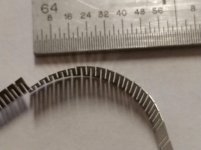KilrB
Stainless
- Joined
- Feb 18, 2007
- Location
- Angleton, Texas
We are having a real problem stamping spring from annealed Inconel 718.
We have a die that makes this same spring from .006" thick 302FH and Elgiloy with no problem.
It will punch and form hundreds of feet, 12 slots at a time.
New customer wants this spring, and several others, from annealed Inconel 718 … no problem right?
Wrong!!!
We've had to reduce the punch count to four and reduce the die block thickness just to get a few dozen feet before the punches wear out and/or break.
Punches and die blocks are made of PMM4 @ 65 Rc. Punches have 4 degrees shear from open end of slot to closed.
We have tried switching to Z-TUFF PM and Z-MAX PM with no appreciable improvement.
Reversing the direction of the shear is the only thing that as yielded positive results and that not much.
Cannot show you pictures of die, but pictures of spring I can.



We have a die that makes this same spring from .006" thick 302FH and Elgiloy with no problem.
It will punch and form hundreds of feet, 12 slots at a time.
New customer wants this spring, and several others, from annealed Inconel 718 … no problem right?
Wrong!!!
We've had to reduce the punch count to four and reduce the die block thickness just to get a few dozen feet before the punches wear out and/or break.
Punches and die blocks are made of PMM4 @ 65 Rc. Punches have 4 degrees shear from open end of slot to closed.
We have tried switching to Z-TUFF PM and Z-MAX PM with no appreciable improvement.
Reversing the direction of the shear is the only thing that as yielded positive results and that not much.
Cannot show you pictures of die, but pictures of spring I can.






 Is the shear one direction? Are the punches/can the punches be polished in the direction of the stamping to reduce any friction? Coatings? We used to see an increase in punch life (depending on a few factors but) by altering shear, even a little bit- for example on some round punches we could get improved life by grinding a conical shear on them, or grinding the shear in a "V" shape.
Is the shear one direction? Are the punches/can the punches be polished in the direction of the stamping to reduce any friction? Coatings? We used to see an increase in punch life (depending on a few factors but) by altering shear, even a little bit- for example on some round punches we could get improved life by grinding a conical shear on them, or grinding the shear in a "V" shape.

